Definition: Circular flow of Income refers to the movement of money and goods, in the economy, across the various sectors, i.e. household, firm, government and foreign sector, in a circular flow.
An economy can be defined as a unified arrangement of production, distribution, exchange, consumption and investment.
These processes play a crucial role in the survival and growth of the economy. Consumers buy the goods and services produced by the producers for money, which generates income. And so, the income generated in the process moves in a circular motion. This is called the circular flow of income. Further, it is an ongoing process, as there is no end to the flow.
Economic Sectors
An economy is classified into four broad sectors, these are: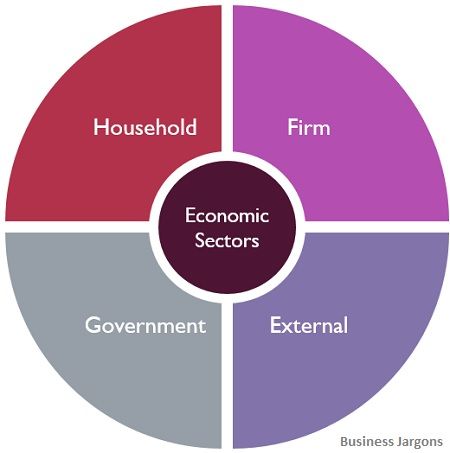
- Household Sector: This sector covers consumer of goods and services, who buys them for their personal consumption. The household sector owns the inputs, i.e. factors of production and renders factor services to the producer sector.
- Producer Sector: All the producer firms and establishments fall under this category. Firm employ factors of production, i.e. land, labour, capital and entrepreneur, so as to produce goods and services. As the inputs are owned by the households, factors payments are made to them in the form of rent, salary and wages, interest and profit.
- Government Sector: It is the third sector of the economy which earns revenue in the firms, households and foreign sectors, in the form of taxes, fees, duties, and proceeds from the sale of goods and services. Also, the government makes factor payments to the households and provides public utility services to the general public.
- External Sector: It is the foreign sector which receives money for the export of goods and services to the firms, household and government. Also makes payment to the other sectors for the import of goods and services.
Types of Circular Flow of Income
There are two types of circular flow, explained hereunder: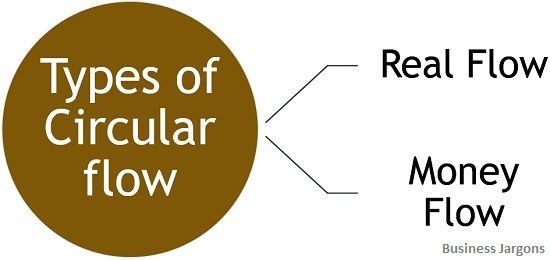
- Real Flow: Otherwise called as Product Flow or Output Flow, it implies the movement of factor services and, goods and services among different sectors of the economy. Thus, it comprises of:
- Factor Flow
- Product Flow
- Money Flow: Money Flow or Nominal flow involves the exchange of goods and services for money. Households provide factor services to the firm, in the form of land labour, capital and entrepreneur and get factor payments for the same, in terms of money. Now the money received is spent on buying goods and services produced by the firm.
Phases of Circular Flow of Income
In general, circular flow is bifurcated into three major phases which are: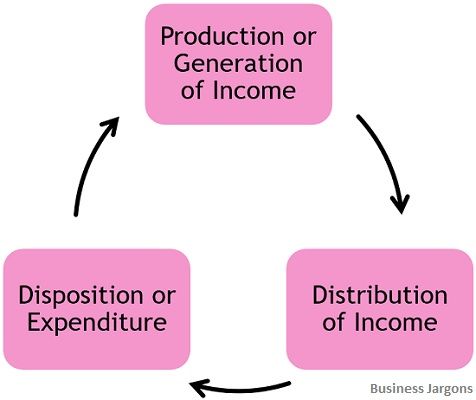
- Production Phase: In this phase, goods and services are manufactured by the firms, by making use of inputs, for the purpose of production of goods and services. As it leads to the generation of income, it is called a generation phase.
- Distribution Phase: In this part, the firm makes factor payments to the households, in the form of rent, wages, interest and profit, for the factor services provided by them. Hence, there is a distribution of income.
- Disposition Phase: Finally, the factor incomes received is invested in the purchase of goods and services for the purpose of consumption. Hence, there is the disposition of income in this phase.
Circular Flow of Income in a Two-Sector Economy
To indicate the circulation of income and expenditure in a two-sector economy, the economy is broadly divided into two groups – Household and Firms.
The figure shown below represents the circular flow of income in a two-sector economy: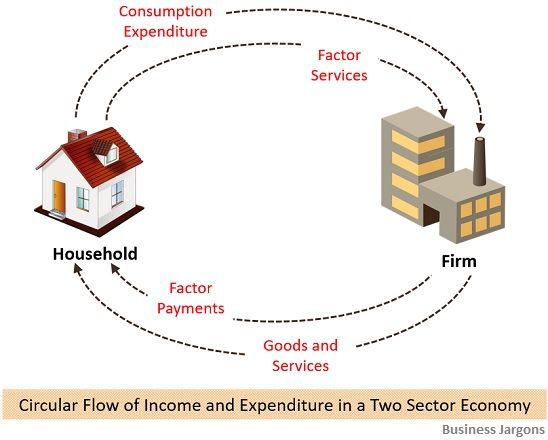
Assumptions of Two-Sector Economy
- In a two-sector economy, there are two major sectors or groups, – producers which are referred to as firms and consumers, i.e. households.
- Households provide factor services to the firm and firms receive factor services from households.
- Entire Income earned by the households is spent on consumption.
- All the goods and services produced by the firms are sold to households.
- No third sector (government or foreign) is present in the economy.
- There are two types of market in this economy, – product market and factor market.
- There is no leakage, in the form of savings or taxes.
Hence in a simple economy,
- Aggregate production of goods and services by the producers is equal to the Aggregate consumption of goods and services by consumers.
- Factor payments by firms are equal to factor incomes of households.
- Consumption expenditure on food, clothing, health, education, etc. of households is equal to the sales revenue of the firm. This means that the total income of the economy comes back to the firms in the form of sales revenue.
- Real flow is equal to money flow.
Circular Flow of Income in a Two-Sector Economy with the Financial System
Firms and households often save a part of their income, which results in leakage from the circular flow of income. The amount is saved in the financial institutions like banks. Further, the firms also borrow money from the financial system for making an investment, which results in the injection of money into the circular flow.
Hence, financial institutions perform the role of intermediaries amidst savers and investors. So, without referring to the financial system, the understanding of the economic activities will not be complete.
The figure given below indicates the circular flow of income in a two-sector economy, with the financial system: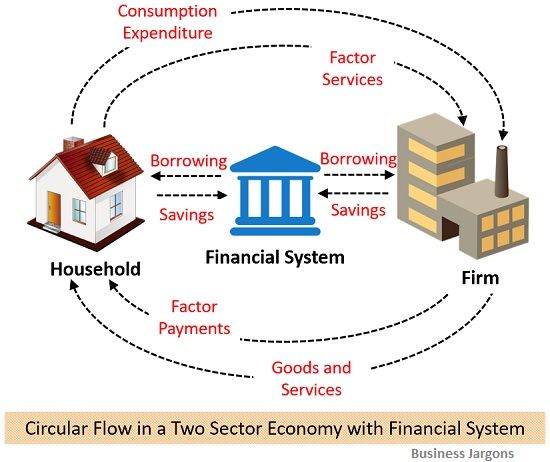
Circular Flow of Income in Three Sector Economy
In a three-sector economy, there are three major sectors: Households, Firms, and Government.
The figure depicted below highlights the circular flow of income in a three-sector economy.
Assumptions of Three-Sector Economy
- The government earns revenue in the form of taxes, from households and firms.
- Transfer payments are made by the Government to the household sector and provide subsidies to the business sector.
- Savings of the government moves to the financial market and raises loan from the financial system.
Circular Flow of Income in Four Sector Economy
Four Sector Economy, as the name suggests is broadly classified into four major groups, i.e. households, firms, government and external sector. It represents an open economy, wherein imports and exports with the other countries of the world take place.
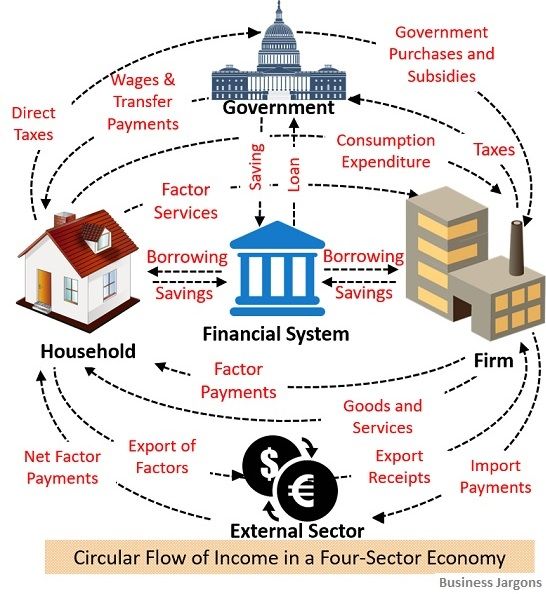 Take a look at the figure given below, which represents the circular flow of income in a four-sector economy:
Take a look at the figure given below, which represents the circular flow of income in a four-sector economy:
Assumptions of Four-Sector Economy
- The firm receives payment from the external sector for the exports, while the payment is made to the external sector for the imports.
- Factor services are provided by the household sector to the external or foreign sector, for which it receives net factor payments.
Hence, the circular flow of income focuses on the movement of money among different sectors which are operating in an economy.

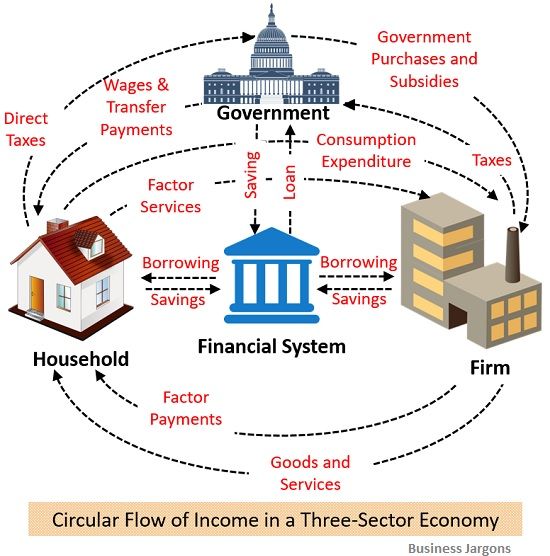
Sandhya says
Thank you for your answer